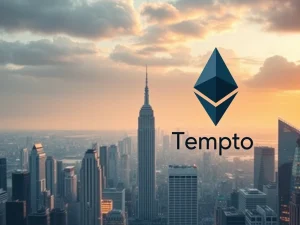Ethereum Unleashed: Aave Withdrawals Spark 10% Lending Rate Shockwave and Market Turmoil

The world of decentralized finance (DeFi) is rarely calm, but recent events surrounding **Ethereum** have sent shockwaves across the ecosystem. A staggering $1.7 billion worth of Ethereum (ETH) was withdrawn from the prominent DeFi protocol Aave in a single week, triggering unprecedented market volatility and significantly disrupting lending dynamics. This sudden exodus didn’t just move funds; it ignited a surge in borrowing rates, forcing a re-evaluation of strategies reliant on low-interest loans. For anyone invested in crypto, understanding these movements is crucial.
What Triggered the Aave Lending Rate Surge?
The core of the recent upheaval lies in the massive **Ethereum** withdrawals from Aave. When such a significant amount of capital is pulled from a lending pool, the supply of available assets for borrowing decreases. In a decentralized market, this scarcity directly impacts borrowing costs.
- Sudden Outflows: A total of $1.7 billion in ETH was withdrawn from Aave within a single week. This rapid movement by large investors, often referred to as ‘whales,’ dramatically reduced the liquidity available for lending.
- Supply and Demand Imbalance: With less ETH available to borrow, but potentially similar or even increased demand, the fundamental economic principle of supply and demand dictates that the price of borrowing (the interest rate) must rise.
- Lending Rate Spike: Consequently, borrowing rates on Aave soared above 10%. This dramatic increase made previously profitable leveraging strategies, particularly ‘looping’ (reinvesting borrowed Ethereum), untenable for many users.
- Forced Position Closures: Investors who had employed looping strategies found their positions becoming unprofitable, leading to rapid closures and increased unstaking activity through liquid staking providers. This further contributed to the outflow pressure.
The ripple effect extended to the Ethereum network’s unstaking queue, which hit a record high of 627,944 ETH (approximately $2.3 billion) awaiting unstaking. This volume is projected to take around 11 days to process, highlighting the strain on the network’s capacity and the sheer scale of the recent movements.
Is Justin Sun Behind the Major **Aave** Withdrawals?
One of the most compelling narratives surrounding these withdrawals points to a familiar name in the crypto space: **Justin Sun**. Marc Zeller, an Aave developer, cited Sun—founder of Tron and a prominent crypto billionaire—as the likely orchestrator of a significant portion of the withdrawals. While Sun has not publicly confirmed his involvement, on-chain data provides some intriguing clues:
- Arkham Tracking: Wallets attributed to Justin Sun, tracked via platforms like Arkham, reportedly withdrew $646 million in ETH from Aave over a three-day period.
- HTX-Affiliated Wallet: An HTX-affiliated wallet also saw substantial activity, netting $455 million in ETH withdrawals during the same timeframe.
- Remaining Holdings: Despite these massive outflows, Sun’s accounts reportedly still hold $80 million in ETH on Aave, suggesting a strategic, rather than complete, withdrawal.
It’s important to note that while Zeller’s assertion is based on on-chain analysis, the true motivations behind such large-scale movements often remain shrouded in speculation. However, the sheer size of these transactions underscores the significant influence that a few large players can exert on **DeFi lending** protocols and the broader market.
Broader Market Impact: Understanding **Crypto Volatility**
Beyond the direct impact on Aave, these withdrawals contribute to the broader narrative of **crypto volatility**. While the market has seen a bullish phase for Ethereum, fueled by institutional inflows and ETF demand, large whale movements can amplify short-term price swings.
For instance, London-based Abraxas Capital Management also withdrew $115 million in Ethereum from Aave, indicating a broader investor caution. Separately, a whale offloaded 8,005 ETH (worth $30.03 million) at $3,751 per token, a clear example of profit-taking amidst rising prices. This behavior aligns with Ethereum’s 2025 rally, but also serves as a reminder that rapid liquidations can introduce significant price pressure.
Market observers emphasize that whale behavior—including erratic deposits and withdrawals—remains a critical barometer for Ethereum’s trajectory. These movements often precede or coincide with significant price action, making on-chain monitoring an essential tool for investors. The withdrawals coincide with Ethereum’s 25% weekly price surge, driven by speculative buying and ETF-related optimism. However, the lack of direct confirmation from **Justin Sun** and other large holders means the true motivations remain unclear, necessitating continued vigilance from market participants.
Actionable Insights for Navigating DeFi Lending
In a landscape marked by such significant shifts, how can investors navigate the **DeFi lending** space and protect their assets?
- Monitor On-Chain Data: Tools like Arkham and Etherscan provide invaluable insights into large wallet movements. While not always definitive, they can help identify potential trends or large-scale position adjustments.
- Understand Protocol Risks: Familiarize yourself with the liquidation thresholds and interest rate mechanisms of any DeFi protocol you use. The Aave incident highlights how quickly rates can change, impacting leveraged positions.
- Diversify Strategies: Avoid over-reliance on a single, highly leveraged strategy. Diversifying across different protocols or even different asset classes can mitigate risks associated with sudden market shifts.
- Stay Informed: Keep abreast of major news, network upgrades, and significant whale activities. These factors can profoundly influence market dynamics and the profitability of DeFi strategies.
- Risk Management: Always maintain adequate collateralization ratios and be prepared to add more collateral or close positions if market conditions deteriorate rapidly. The 10% rate surge on Aave serves as a stark reminder of the importance of proactive risk management.
The Road Ahead for Ethereum and DeFi
The recent events underscore the inherent dynamism and occasional unpredictability of the **Ethereum** and DeFi ecosystems. While large withdrawals can create short-term turbulence and significant rate adjustments on platforms like Aave, they don’t necessarily signal a broader downturn for Ethereum. The network continues to evolve with upcoming upgrades, and institutional interest, particularly around ETFs, remains a strong underlying bullish factor.
The key takeaway is that transparency in DeFi, though often touted, is sometimes incomplete when it comes to the ‘why’ behind major movements. While we can see the transactions, the strategic intent of entities like Justin Sun or large capital management firms remains speculative. For investors, this means a continued emphasis on understanding on-chain data, robust risk management, and adapting to a rapidly evolving market. The Aave withdrawals serve as a powerful case study in how quickly lending rates can shift and the profound impact of whale activity on decentralized finance.
Frequently Asked Questions (FAQs)
What is Aave and how does it work?
Aave is a decentralized non-custodial liquidity protocol where users can participate as depositors or borrowers. Depositors provide liquidity to earn passive income, while borrowers can take out loans (often overcollateralized) by paying interest. The interest rates are algorithmically determined based on the supply and demand of assets within the protocol’s liquidity pools.
Why did Aave’s lending rates surge after the Ethereum withdrawals?
When a large amount of Ethereum (ETH) was withdrawn from Aave’s liquidity pools, the supply of ETH available for borrowing significantly decreased. According to the basic principles of supply and demand, if demand for borrowing remains high but supply shrinks, the interest rate (the cost of borrowing) naturally increases. This led to rates surging above 10%.
What is ‘DeFi looping’ and why did it become unprofitable?
DeFi looping is a strategy where an investor repeatedly borrows an asset (e.g., ETH) against their collateral and then reinvests the borrowed amount back into the same or another lending protocol to earn more yield. This creates a ‘loop’ of borrowing and lending. It became unprofitable when Aave’s borrowing rates surged above 10%, making the cost of borrowing higher than the potential yield earned from reinvesting, thus eroding profits or leading to losses.
Who is Justin Sun and what is his connection to these withdrawals?
Justin Sun is a prominent figure in the cryptocurrency space, founder of the Tron blockchain, and a known crypto billionaire. An Aave developer cited on-chain data suggesting wallets linked to Justin Sun were responsible for a significant portion of the recent $1.7 billion Ethereum withdrawals from Aave. While Sun has not confirmed his involvement, his past actions and large holdings often make him a subject of interest in major market movements.
What are the implications of these withdrawals for Ethereum holders?
For direct Ethereum holders, these withdrawals primarily highlight market volatility and the influence of large players. While the withdrawals from Aave specifically impact lending rates on that platform, the resulting unstaking queue and general market sentiment can contribute to short-term price fluctuations. It underscores the importance of monitoring on-chain activity and understanding the broader market dynamics beyond just price charts.










